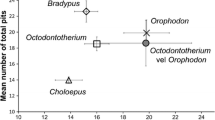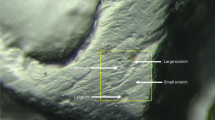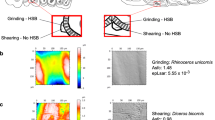Abstract
Tooth microwear was analyzed for a large sample of wild-shot barren-ground caribou (Rangifer tarandus groenlandicus) from the Kaminuriak population of eastern Canada. This sample was compared to the microwear of specimens from three Pleistocene localities in North America (Alaska) and western Europe (Caune de l’Arago in France and Salzgitter in Germany). The results show that the extant samples from eastern Canada have seasonal variation in microwear and presumably in diet. The differences in microwear between the various seasons may reflect a cyclic migration of the population within a year. The extinct population from Alaska has extremely blunt teeth (mesowear), as blunt as those of modern zebras and bison. This observation is corroborated by the lowest number of microwear pits. The findings are untypical, as most typical caribou teeth have sharper apices, and we interpret this as an indication of a local habitat that was different with animals feeding on non-typical vegetation. The combination of Rangifer from Caune de l’Arago and Salzgitter reveals a pattern in microwear variability. The Salzgitter is interglacial and shows a greater diversity of browsing (broad spectrum on average number of pits) than the glacial Caune de l’Arago. The interglacial population from Salzgitter is interesting because it shows several different types of browsing. Collectively all the Rangifer teeth show that diet of a brachydont taxon can vary across most of the dietary morphospace of ungulates as represented by tooth microwear. The three Pleistocene samples exhibit microwear that is different from the extant population in question. This observation implies that the recent diet of Rangifer has changed from the typical caribou diet in the past. This indicates dietary change within a species. This is important because it represents dietary evolution without changes in tooth morphology.



Similar content being viewed by others
References
Bergerud AT (1972) Food habits of the Newfoundland caribou. J Wildl Manage 36:913–923
Bergerud AT (1978) Caribou. In: Schmidt JL, Gilbert DL (eds) Big game of North America: ecology and management. Stackpole, Harrisburg, pp 83–101
Bergerud AT (2000) Caribou. In: Demarais S, Krausman PR (eds) Ecology and management of large mammals in North America. Prentice-Hall, Upper Saddle River, NJ, pp 658–693
de Lumley H, Fournier A, Park YC, Yokoyama Y, Demouy A (1984) Stratigraphie du remplissage Pléistocène moyen de la Caune de l’Arago à Tautavel. Etude de huit carottages effectués de 1981 à 1983. L’Anthropologie 88:5–18
Drucker D, Bocherens H, Pike-Tay A, Mariotti A (2001) Isotopic tracking of seasonal dietary change in dentine collagen: preliminary data from modern caribou. C R Acad Sc Paris 333:303–309
Fortelius M, Solounias N (2000) Functional characterization of ungulate molars using the abrasion-attrition wear gradient: a new method for reconstructing paleodiets. Am Mus Novit 3301:1–36
Gaudzinski S, Roebroeks W (2000) Adults only. Reindeer hunting at the Middle Palaeolithic site Salzgitter Lebenstedt, Northern Germany. J Hum Evol 38:497–521
Godfrey LR, Semprebon GM, Jungers WL, Sutherland MR, Simons EL, Solounias N (2004) Dental use wear in extinct lemurs: evidence of diet and niche differentiation. J Hum Evol 47:145–169
Guthrie RD (1968) Paleoecology of the large-mammal community in interior Alaska during the late Pleistocene. Am Midl Nat 79:346–363
Huntley B, Webb T (1989) Migration species’ response to climatic variations caused by changes in the earth’s orbit. J Biogeogr 16:5–19
Johnsingh AJT, Sankar K (1991) Food plants of chital, sambar, and cattle on Mundanthurai Plateau, Tamil Nadu, south India. Mammalia 55:57–66
Khan JA (1994) Food habits of ungulates in dry tropical forests of Gir Lion Sanctuary, Gujarat, India. Acta Theriol 39:185–193
Klein DR (1992) Comparative ecological and behavioral adaptations of Ovibos moschatus and Rangifer tarandus. Rangifer 12:47–55
Larter NC, Nagy JA (1997) Peary caribou, muskoxen and Banks Island forage: assessing seasonal diets similarities. Rangifer 17:9–16
Merceron G, Madelaine S (2006) Molar microwear pattern and palaeoecology of ungulates from La Berbie (Dordogne, France): environment of Neanderthals and modern human populations of the Middle/Upper Palaeolithic. Boreas 35:272–278
Merceron G, Viriot L, Blondel C (2004) Tooth microwear pattern in roe deer (Capreolus capreolus L.) from Chizé (Western France) and relation to food composition. Small Rumin Res 53:125–132
Miller FL (1974) Biology of the Kaminuriak population of barren-ground caribou. Part 2: dentition as an indicator of age and sex; composition and socialization of the population. Can Wildl Serv Rep Ser 31:1–87
Miller DR (1976) Biology of the Kaminuriak population of barren-ground caribou. Part 3: Taiga winter range relationships and diet. Can Wildl Serv Rep Ser 36:1–37
Miller FL (1982) Caribou—Rangifer tarandus. In: Chapman JA, Feldhamer GA (eds) Wild mammals of North America. Biology, Management, and Economics. The Johns Hopkins University Press, Baltimore, pp 923–959
Ngampongsai C (1987) Habitat use by the Sambar (Cervus unicolor) in Thailand: a case study for Khao-Yai National Park. In: Wemmer CM (ed) Biology and Management of the Cervidae. Smithsonian Institution Press, Washington, DC, pp 289–298
Nowak RM (1999) Walker’s mammals of the world. The Johns Hopkins University Press, Baltimore
Palombo MR, Filippi ML, Iacumin P, Longinelli A, Barbieri M, Maras A (2005) Coupling tooth microwear and stable isotope analyses for palaeodiet reconstruction: the case study of late middle Pleistocene Elephas (Palaeoloxodon) antiquus teeth from Central Italy (Rome area). Quat Int 126–128:153–170
Pike-Tay A (1995) Variability and synchrony of seasonal indicators in dental cementum microstructure of the Kaminuriak caribou population. Archaeofauna 4:273–284
Pike-Tay A, Morcomb CA, O’Farrell M (2000) Reconsidering the Quadratic Crown Height Method of age estimation for Rangifer from archaeological sites. Archaeozoologia 11:145–174
Rensberger JM (1978) Scanning electron microscopy of wear and occlusal events in some small herbivores. In: Butler PM, Joysey KA (eds) Development, function and evolution of teeth. Academic Press, London, pp 415–438
Rivals F, Deniaux B (2005) Investigation of human hunting seasonality through dental microwear analysis of two Caprinae in late Pleistocene localities in Southern France. J Archaeol Sci 32:1603–1612
Rivals F, Kacimi S, Moutoussamy J (2004) Artiodactyls, favourite game of prehistoric hunters at the Caune de l’Arago Cave (Tautavel, France). Opportunist or selective hunting strategies? Eur J Wildl Res 50:25–32
Rivals F, Mihlbachler MC, Solounias N (2007a) Effect of ontogenetic-age distribution in fossil samples on the interpretation of ungulate paleo-diets using the mesowear method. J Vertebr Paleontol (in press)
Rivals F, Solounias N, Mihlbachler MC (2007b) Evidence for geographic variation in the diets of late Pleistocene and early Holocene Bison in North America, and differences from the diets of recent Bison. Quat Res (in press)
Schaller GB (1967) The deer and the tiger. The University of Chicago Press, Chicago
Skoog RO (1968) Ecology of the caribou (Rangifer tarandus granti) in Alaska. Ph.D. dissertation, University of California, Berkeley
Semprebon GM, Godfrey LR, Solounias N, Sutherland MR, Jungers WL (2004) Can low-magnification stereomicroscopy reveal diet? J Hum Evol 47:115–144
Solounias N, Moelleken SMC (1992) Dietary adaptation of two goat ancestors and evolutionary considerations. Geobios 25:797–809
Solounias N, Moelleken SMC (1994) Dietary differences between two archaic ruminant species from Sansan, France. Hist Biol 7:203–220
Solounias N, Semprebon G (2002) Advances in the reconstruction of ungulate ecomorphology with application to early fossil equids. Am Mus Novit 3366:1–49
Solounias N, Teaford M, Walker A (1988) Interpreting the diet of extinct ruminants: the case of a non-browsing giraffid. Paleobiology 14:287–300
Stephenson RO, Gerlach SG, Guthrie RD, Harington CR, Mills RO, Hare G (2001) Wood bison in late Holocene Alaska and adjacent Canada: paleontological, archaeological and historical records. In: Gerlach SG, Murray MS (eds) People and wildlife in Northern North America: essays in honor of R. Dale Guthrie, Archaeopress, Oxford, pp 125–159
Vrba ES (1992) Mammals as a key to evolutionary theory. J Mammal 73:1–28
Walker A, Hoek HN, Perez L (1978) Microwear of mammalian teeth as an indicator of diet. Science 201:908–910
Wilkerson AS, Kaisen PC (1932) Some frozen deposits in the goldfields of interior Alaska. A study of the Pleistocene deposits of Alaska. Am Mus Novit 525:1–22
Yesner DR (2001) Human dispersal into interior Alaska: antecedent conditions, mode of colonization, and adaptations. Quat Sci Rev 20:315–327
Acknowledgements
We are grateful to Gina Semprebon for help and discussions and Renata Trister for help with the manuscript. We also thank the two anonymous reviewers, and John Wible, the editor, for helpful comments on an earlier version of this manuscript. We thank the museums who provided access to specimens, in particular we are grateful to: J. Flynn, J. Meng, C. Norris, J. Galkin (Department of Vertebrate Paleontology, American Museum of Natural History, New York), E. Westwig (Department of Mammalogy, American Museum of Natural History, New York), R. White (Department of Anthropology, New York University), H. de Lumley (Institut de Paléontologie Humaine, Paris), and W.-D. Steinmetz (Braunschweigisches Landesmuseum, Wolfenbuttel). We thank the French ministry of foreign affairs and the Alexander von Humboldt Foundation for fellowship grants to FR.
Author information
Authors and Affiliations
Corresponding author
Rights and permissions
About this article
Cite this article
Rivals, F., Solounias, N. Differences in Tooth Microwear of Populations of Caribou (Rangifer tarandus, Ruminantia, Mammalia) and Implications to Ecology, Migration, Glaciations and Dental Evolution. J Mammal Evol 14, 182–192 (2007). https://doi.org/10.1007/s10914-007-9044-8
Received:
Accepted:
Published:
Issue Date:
DOI: https://doi.org/10.1007/s10914-007-9044-8




